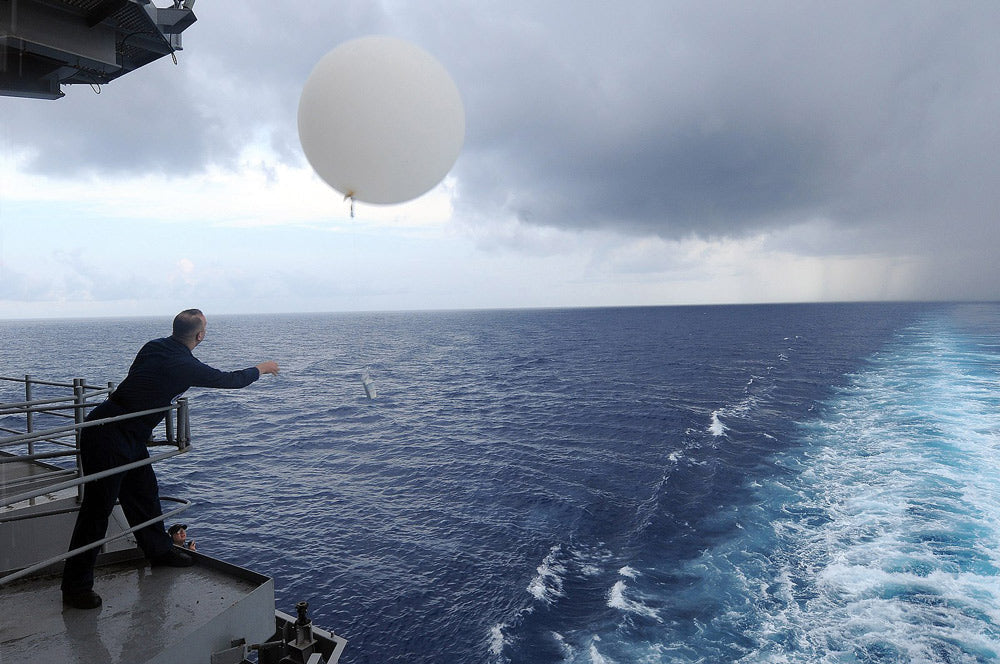Weather Balloons Threaten Sea Turtles with Deadly Ocean Debris
Matthew Russell
Weather balloons play a crucial role in forecasting, helping to predict everything from daily weather to severe storms. But while these balloons serve a vital purpose for humans, their environmental impact, particularly on marine life, is becoming impossible to ignore. Sea turtles are among the many species threatened by the debris left behind when weather balloons burst and fall into the ocean. Despite the importance of weather data collection, the toll on these creatures is significant and demands urgent attention.

Photo: Wikimedia Commons / Yellowstone National Park, License: Public Domain
Weather balloons are harming sea turtles in oceans around the world.
Weather Balloons and Their Debris
Each year, more than 100,000 weather balloons are launched worldwide, with the United States alone responsible for deploying around 76,600 of them annually, according to a report from the Environmental Health Network. These balloons ascend to heights of over 35 kilometers before they expand and burst, scattering debris like latex and strings back to Earth. Much of this debris ends up in oceans, where it poses a hidden but deadly threat to marine wildlife, especially sea turtles.
The problem starts with how sea turtles perceive these floating objects. To a sea turtle, a deflated balloon drifting in the water resembles a jellyfish, one of their primary food sources. When a turtle ingests this balloon, the consequences are often fatal. Balloons and other debris can block a turtle’s digestive system, leading to starvation and eventual death. As KIII TV reports, local experts in Corpus Christi, Texas, frequently encounter sea turtles that have ingested balloon fragments.
The Scale of the Threat
While the precise number of sea turtles harmed by balloon debris is unknown, experts are beginning to grasp the extent of the problem. Balloons are among the top ten types of debris found during coastal cleanups, with their presence increasing significantly in recent years. The Tangaroa Blue Foundation estimates that up to 70% of Australia’s weather balloons end up in the ocean. Over just 21 months, the foundation collected more than 2,400 pieces of balloon debris around the Great Barrier Reef, a critical habitat for marine species, including endangered sea turtles.
Juvenile Kemp’s ridley turtles, one of the most endangered species in the world, have been found entangled in weather balloon strings off the coast of Virginia. A report from Hakai Magazine highlights one instance where a Kemp’s ridley was discovered with string wrapped around its flippers, restricting its movement and ability to feed.


Photo: Wikimedia Commons / NOAASatellites, License: Public Domain
Balloon strings entangle marine animals, causing injuries and death. Balloon strings entangle marine animals, causing injuries and death.
The Consequences of Entanglement
For sea turtles, entanglement in weather balloon strings is equally devastating. Once tangled, turtles can become immobilized, rendering them unable to swim or escape predators. Jace Tunnell, Reserve Director at the University of Texas Marine Science Institute, sees these cases regularly. As he explained to KIII TV, turtles can suffer injuries when they try to bite through balloon fragments, mistaking them for food. These seemingly small pieces of debris can lead to life-threatening conditions for the turtles.
At the Texas State Aquarium’s Wildlife Rescue Center, injured sea turtles regularly arrive with debris-related injuries. Jesse Gilbert, President and CEO of the aquarium, described how difficult it can be to treat turtles that have ingested foreign debris like balloon strings and plastic. "We’ve actually had turtles where we can see fishing line coming out of their mouth, and we can actually see it coming out of the other end," he told KIII TV.

Photo: Wikimedia Commons / U.S. Navy photo by Mass Communication Specialist 2nd Class Joel Carlson, License: Public Domain
Balloon debris is one of the top marine pollutants.
Finding Solutions
The impact of weather balloon debris on sea turtles is an environmental issue that can no longer be ignored. Fortunately, some efforts are being made to mitigate the problem. According to Hakai Magazine, the Finnish company Vaisala, a major manufacturer of weather balloon equipment, has introduced biodegradable materials, such as cellulose-based strings, that break down more quickly in marine environments. While these innovations are promising, they come with a higher cost—around 20 to 30 percent more expensive than traditional materials.
At the same time, agencies like NOAA (National Oceanic and Atmospheric Administration) are testing alternative data-gathering devices like drones, which could reduce reliance on weather balloons. Drones can be recovered after use, minimizing the environmental impact. But for now, weather balloons remain essential for collecting high-altitude data, which means the debris they leave behind will continue to pose a threat to sea turtles and other marine wildlife.

Many marine animals die unnoticed, their deaths undocumented.
What Can Be Done?
Awareness and action are key to reducing the harm weather balloons inflict on sea turtles. Tunnell, who routinely finds balloon debris during his trips to the beach, urges beachgoers to pick up trash—even if it’s not their own—to help protect marine life.
On a broader scale, there is a growing call for more stringent regulations regarding balloon releases, particularly those used for weather forecasting. Until new, less harmful technologies are widely adopted, the environmental cost of weather balloons will remain a pressing issue.
Weather balloons, while vital for meteorology, are taking a toll on sea turtles and other marine animals. The debris from these balloons, whether ingested or entangling, poses life-threatening risks to sea turtles. While some strides are being made to reduce this impact, the road ahead is long. Protecting sea turtles will require increased awareness, stricter regulations, and continued innovation to develop safer alternatives to traditional weather balloons. For now, the oceans and their inhabitants need our help to ensure these essential data-gathering tools do not continue to harm the very wildlife they were never meant to affect.
Click below to take action for marine life.

